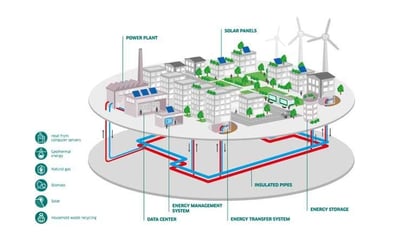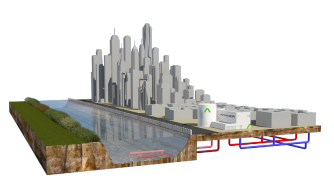In this new era that is the 21ST century, we have the possibility to re-adjust our tools, objectives and technologies to aim towards a greener, more efficient and sustainable future.
During the last years, District Energy has been gaining relevance over conventional technologies. Particularly speaking about District Cooling for countries where the cooling is part of the day to day because of the hot climate conditions and is being produced by conventional equipment which are not the more advanced and efficient solutions of the market.
Traditional cooling systems are evolving towards more efficient and environmentally friendly models, such as District Cooling. This centralised approach not only reduces environmental impact, but also optimises energy and water consumption. However, recent developments are making a difference in the sector.
Below, we explore the key factors and emerging innovations that are transforming the sustainable cooling industry.
Key factors for sustainability in Cooling Systems
There are some factors to take into consideration to make choices regarding the sustainable air cooling systems nowadays, the below mentioned are some of the most relevant.
1. Energy efficiency and water consumption for a sustainable air-cooled cooling system.
According with the International Energy Agency (IEA) 20% of the total electricity being used worldwide every year is for cooling purposes. That is why is so important to increase the efficiency in this kind of applications and save energy. Power and water consumption are two of the main targets of every District Cooling Plant, the sustainability of a system can be determined depending on the climatic conditions and the application of different condensing technologies.
Some examples of efficient and ecological heat dissipation systems integrated to a District Cooling System are:

Air-coolers combined with Solar energy
It is widely recognized that air-Cooled technology, while commonly used, is not the most energy-efficient cooling solution when compared to alternative methods such as water-cooled systems. However, recent advancements in air cooler technology, particularly when combined with solar energy as a primary power source, present a highly promising and sustainable alternative. This innovative combination offers significant environmental and operational advantages, primarily due to its zero water consumption and zero water contamination, making it an ideal solution for regions facing water scarcity or strict environmental regulations.
Beyond water conservation, integrating solar energy with air-cooled systems provides another crucial benefit: zero reliance on fossil fuels for electricity generation. By utilizing renewable energy, this approach not only reduces greenhouse gas emissions but also contributes to long-term energy cost savings. In many areas where solar radiation is abundant, harnessing the power of the sun to operate air coolers enhances energy independence, decreases the strain on traditional power grids, and aligns with global sustainability goals aimed at reducing carbon footprints.

Seawater-cooled Condensers
This type of condensing technology is considered one of the most environmentally friendly solutions available today. It effectively combines the high efficiency of liquid-based heat transfer with the use of a natural water source, such as seawater or river water, to enhance cooling performance. By leveraging these naturally available resources, this method ensures high-quality heat transfer while maintaining zero additional water consumption, making it an ideal choice for sustainable cooling applications.
Each district cooling project is unique and comes with its own specific constraints, including factors such as climate conditions, water availability, and infrastructure limitations. However, despite these challenges, this advanced condensing technology can be tailored and implemented to optimize energy efficiency and minimize environmental impact. These solutions exemplify the sustainability potential of district cooling systems, demonstrating how cutting-edge cooling technologies can significantly contribute to resource conservation, energy savings, and reduced carbon footprints.
2. Ecological footprint of cooling systems

This centralized cooling method leaves a minimum footprint in the environment, it has been proven to be sustainable in cooling applications as latest generation developments within developed countries that take these environmental advantages to be sustainable.
The opportunity areas for the District Cooling are set and are clear, there is no doubt that this technology has come to stay and help. This kind of technology is placing the foundations to have among others the following benefits:
- Less ozone depletion potential and global warming substances emissions
- Reduced electricity consumption
- Less water consumption and water contamination due to chemical treatment
- Reduced noise and visual contamination
The future of sustainable cooling
Switching to cleaner, more efficient technologies is no longer an option, it is a necessity. The technology implemented by District Cooling is not only laying the foundations for a greener future, it is also proving that it can reduce the annual Carbon Dioxide emissions by almost 1 Ton of CO2 for every Refrigeration Ton (3.517 kW) delivered.
With advances such as immersion cooling, thermal batteries and the integration of renewable energy, the horizon for sustainable refrigeration is promising. These technologies, combined with stricter international regulations, are paving the way for planet-friendly air conditioning.
At ARANER, we have implemented sustainable cooling solutions in several projects. For example, in the Badra Oil Field, we developed a TESTIAC system that optimises gas turbine power without water consumption, improving energy efficiency. Similarly, in the Abdali District in Amman, Jordan, we designed a centralised heating and cooling plant that has become a benchmark for sustainability in the region.
These cases demonstrate our commitment to implementing advanced technologies that promote a greener and more efficient future. If you are interested in exploring sustainable cooling solutions, contact our team to find the technology that best suits your needs.










